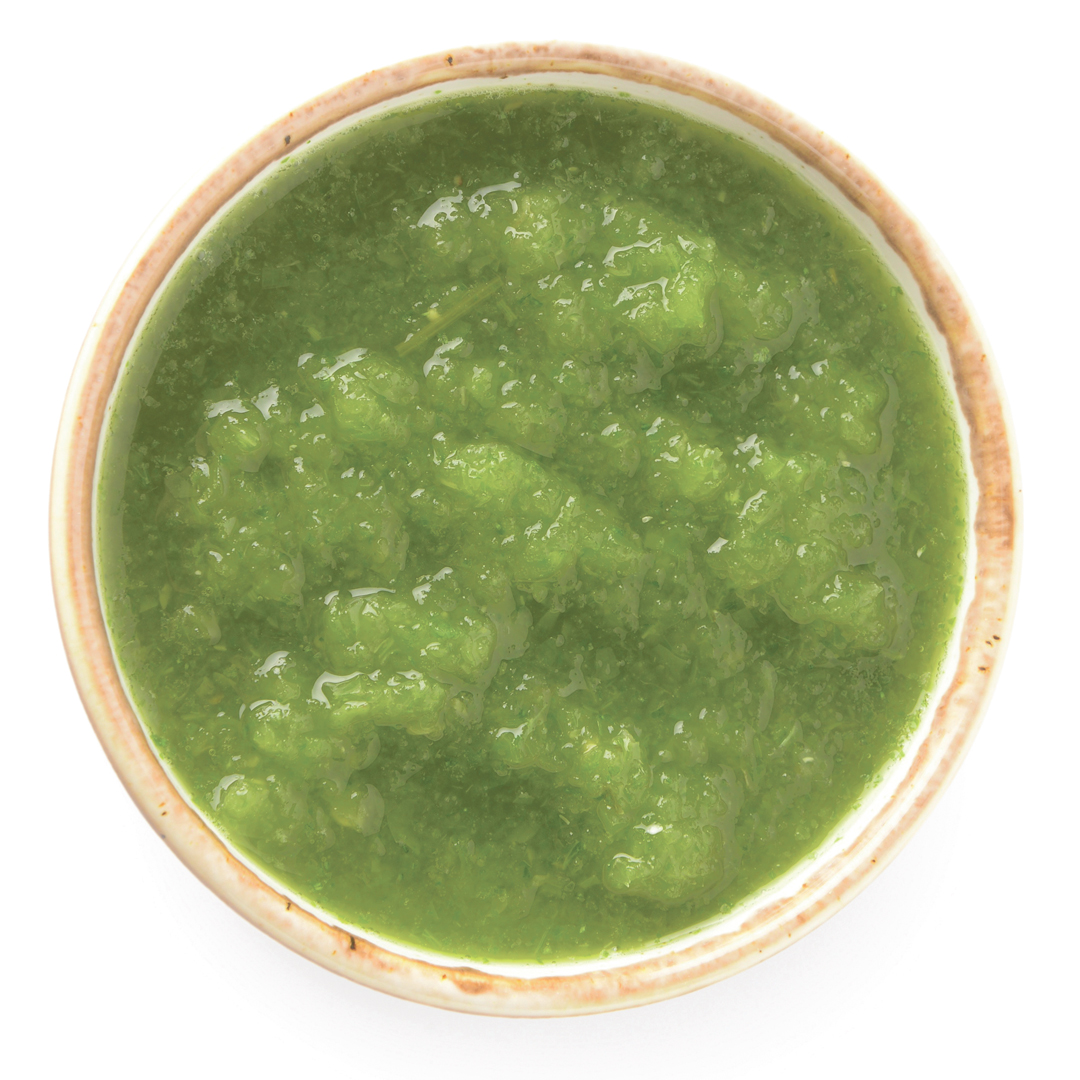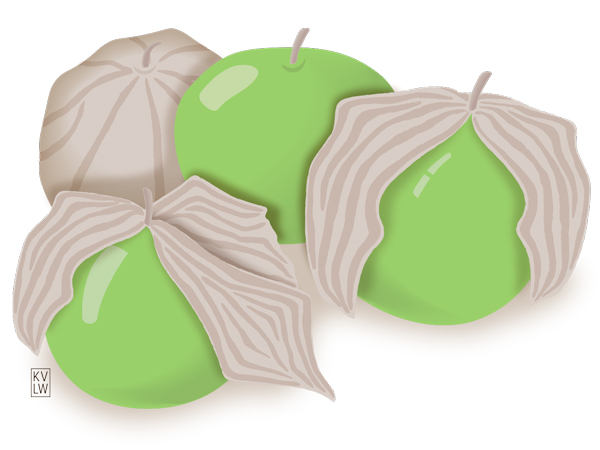
The tomatillo has been cultivated in the Americas for centuries and is a familiar feature in Mexican and Guatemalan dishes. The name comes from tomatl in the Nahuatl language of the Aztecs. It’s likely that the Spaniards confused tomatl with the Nahuatl word for tomato, xitomatl, and thus referred to the green variety of nightshade simply as a small tomato. The tomato became popular around the globe due to its sweetness, but the tart
tomatillo remains a staple of Mexican and Central American cuisine.

Traditionally, the tomatillo is often combined with chiles to balance heat with some cool tanginess. This is the idea behind the chilaquiles at Tres Colores, which is made with both Hatch green chile and tomatillos. I went to Tres Colores for breakfast on a Sunday morning and spoke to Hugo Sena, one of the restaurant’s four owners (including his brother Arturo Sena, who’s also the executive chef). In many of the dishes, Sena explained, “we wanted to mix the old Mexico with the New Mexico. In the chilaquiles, we let the green chile lead the flavor, followed by a little sourness of the tomatillo. It’s a mix that people really seem to like.” The Sena brothers are originally from Veracruz, in southern Mexico. “Southern Mexico has a lot of herbs to play with,” he added, referring to the tropical environment full of fresh ingredients. Indeed, the chilaquiles sauce includes cilantro, oregano, and ground-up bay leaves to give it a strong flavor.
But, as Sena said, the familiar heat and texture of green chile is the star of the dish: large chunks of chopped chile adorn the house-made tortilla chips and eggs. On top are slices of avocado, crumbled queso fresco, chopped cilantro, and a dollop of sour cream. With all these delicious accompaniments, I wasn’t immediately struck by the flavor of tomatillos, but as I ate, I noticed a telltale greenish puree at the base of the dish. The tomatillo sauce softened the chips and complemented the heat from the green chile with its signature tang. The combination of the green chile and tomatillo created an unusual kind of sauce, not overwhelming the eggs and tortillas but offering bursts of spicy, sour flavor throughout. It made for a wonderful version of chilaquiles—a word, I was told by Sena, that also has roots in the Aztec language.

Another sauce with deep Aztec roots is mole. I confess, I’d never tried mole verde prior to my explorations for this story. My knowledge of mole has primarily been limited to the brown mole poblano—rich, chocolaty, earthy, smooth. Mole verde is completely different; after all, mole simply means “sauce.” Like tomatillo, the word came from the Spanish pronunciation of the Nahuatl word for sauce: mulli. The many varieties of mole have little to do with each other when it comes to ingredients and taste.
Mole is a famous Mexican sauce—indeed, mole poblano, often served on chicken or enchiladas, is widely thought of as the “national” dish, though chefs and cooks from regions known for other types of mole might object. Both Puebla and Oaxaca are known for their moles, and each state has its own varieties (with Puebla’s mole poblano being perhaps the best known). The history of mole consists of colorful, and perhaps apocryphal, stories: nuns in Puebla making a special dish for an archbishop using the random ingredients they had, a friar at the same event accidentally knocking various spices into a pot, and even Moctezuma serving it to Cortés in sixteenth-century Tenochtitlan. The common ingredients in these stories are chiles and chocolate, but not all moles are made with chocolate; they do, however, always include some variety of chiles, herbs and spices, and, almost always, fruit (such as tomatoes, plantains, or raisins). The legends are all a bit simple for a dish that is so varied, complex, and time consuming to prepare.
After inspecting the menu at Fiesta Oaxaca online and salivating over the many moles, I went there for lunch with my mom on a quiet Thursday. I already knew my choice: the mole verde pipián under “Oaxacan Especiales.” Mole pipián can be either red or green. The ingredients for pipián verde can vary widely, from lettuce and radish leaves to chard and epazote, but the key ingredient, as in any pipián, is ground-up pumpkin or squash seeds. Fiesta Oaxaca’s version doesn’t use any leafy greens, but the tomatillo lends plenty of color and consistency. I chose the vegan option, which is a relatively new rendition of the classic dish, served with extra-firm tofu mixed with sweet potatoes. We also ordered the Ensalada de Nopalitos y Jicama, a large salad perfect for sharing, with a refreshing blend of flavors and textures—mild and smooth nopal cactus, fresh avocado, crunchy jicama, and sweet raisins served over a bed of lettuce and dressed in a creamy vinaigrette.
Now, as I said, I’m no expert on mole verde pipián, but this sauce seemed pretty close to perfection to me. Light and fresh in flavor, with a slight peppery kick, it was a new experience for this New Mexican used to the punch in the mouth that green chile can bring. The consistency was that of a puree—not chunky like green chile or smooth and syrupy like the mole tamarindo that my mom ordered, but thick enough to coat the tofu and leave me wanting more. The pumpkin seeds, tomatillos, and peanuts give it that texture, and chile de árbol lends the slight bite of heat. Beyond a familiar hint of garlic and onion, which the server, Franco, confirmed were ingredients despite their not being listed on the menu, the rest of the seasoning seems to be a house secret. Some recipes I’ve found add cinnamon, honey, or cumin. Whatever Fiesta Oaxaca’s secret additional herbs may be, the flavor is delightful. It reminded me of what Sena said about southern Mexican states like Veracruz and Oaxaca having more plants to experiment with, such as the herbs epazote and hoja santa, which are among ingredients in other Fiesta Oaxaca dishes. Both restaurants use the inspiration of variety from their origin cuisines, blending a wide array of vegetables, herbs, and chiles on their menus.
Although our idea of “green” here in New Mexico almost always means chile, don’t forget other green ingredients, like the tomatillo, if you’re looking for Mexican flavor and fresh renditions of ancient dishes.
Aria Chiodo
Aria Chiodo originally hails from Taos, and after fifteen years in New York City, she is back in New Mexico, living in Santa Fe. In addition to food writing, she writes film and book reviews, personal and travel essays, and short stories.


